Creating awesome content is not enough.
If you want traffic, you need to build high-quality backlinks. But how do you do that?
There are hundreds of articles listing the best link building strategies but the reality is that you don’t need 100 strategies that make you feel pushy and overwhelmed, you need one strategy that works and makes you feel good about your link building efforts.
This article will help you find it and show you how to avoid a few “backlink killers” that could render all your link building efforts useless.
What are backlinks and inbound links?
Backlinks or inbound links are one of the most important aspects of SEO but what are they exactly?
Quite simply, a backlink is a link from one website to another.
A backlink can either be dofollow or nofollow. A dofollow link is a link that search engines follow and therefore has SEO value while a nofollow link doesn’t have SEO value.
This means that while earning nofollow links can stlll be useful because it can potentially offer traffic and visibility, a dofollow link is always preferable
Why do inbound links matter?

A good backlink is like a positive recommendation letter, it tells search engines that a page deserves to rank high.
Inbound links or backlinks matter because they are one of the best ways for Google to judge how trustworthy your website is.
Think of each backlink as a recommendation letter. Just like having recommendations letters from respected colleagues make you look more trustworthy and likely to get hired, having backlinks from trusted websites makes your website look more trustworthy and therefore more worthy of a high ranking.
You can compensate for the lack of backlinks by having amazing content or by being popular on social media (among other things) but you will struggle to rank for competitive keywords if you don’t have quality backlinks.
That’s why link building is so important.
What is a high-quality backlink?
I just mentioned that backlinks are like recommendation letters for your websites which also mean that there are good and bad backlinks.
There are likely hundreds of criteria Google takes into account to asses the quality of a backlink but an inbound link or backlink is generally considered high-quality if:
- It comes from a trusted source (a backlink from the New York times is better than a backlink from the lifestyle blog your aunt created last week.)
- It looks natural. Google doesn’t like paid links and could penalize you if they suspect you bought a link.
- It’s relevant to your industry. A cooking blog will benefit more from a backlink from a fellow cooking blog than from a backlink from a blog about martial arts.
- It’s dofollow. Nofollowing a backlink is a way to tell Google the backlink shouldn’t count as a recommendation and makes it less useful in term of SEO.
Now comes the millon-dollar question: how to get high-quality backlinks?
How to get high-quality backlinks to your site

Creating awesome content is, unfortunately, not enough to get high-quality backlinks.
Getting high-quality backlinks is simple, in theory.
You create awesome content and people link to it because they can’t wait to share the awesomeness.
Unfortunately, any experienced content writer will tell you it isn’t that easy because:
- No matter how awesome your content is, people aren’t going to link to it if they aren’t aware of its existence.
- People are reluctant to link to content from people they don’t know and trust (just like people are reluctant to write letters of recommendation for strangers.)
These 2 factors explain an unfortunate aspect of SEO called the vicious circle of SEO.
The vicious circle of SEO means that high-ranking websites tend to attract more links just because they rank high. They then keep ranking high because of all the backlinks they get.
While a well-known website can get away with minimal link building, an unknown website is unlikely to ever rank high without employing good link building strategies.
In other words, the less well-known your website is, the harder you need to work to earn backlinks.
My website French Together received 238,717 visitors in the last 30 days and naturally gets mentioned all over the web several times per week as a result of its visibility.

If a website ranks high, it will naturally get quoted more often and attract backlinks. This is the vicious circle of SEO.
In fact, here are just 3 of the dofollow backlinks French Together earned naturally in the last 30 days:
- Cambridge University Press (DR 90)
- Duolingo (DR 84)
- The State Press (DR 71)

These are not backlinks that were earned as a result of link building, these are backlinks that French Together earned naturally just because of its visibility.
In contrast, Grow With Less, a website that was created a few months ago, doesn’t get mentioned anywhere and every link has to be earned.
It’s easy to compare the 2 websites and feel discouraged but it**’s** important to remember that the websites that currently rank at the top of Google used to rank at the bottom when they started.
French Together didn’t magically go from 0 visitors to 238,717, I had to try a lot of different link building strategies to get there.
After lots of trial and error, I finally found a few link building strategies that worked and helped me slowly but surely get more traffic.
These are the link building strategies you will discover in this article
But before I tell you about these strategies, let’s make sure your website is ready to get backlinks.
2 backlink killers that could render your link building efforts useless

Imagine you are about to meet your new work colleague for the first time.
You don’t know much about Mike and don’t know what to expect.
When Mike shows up, he looks unshaved and his cologne reminds you of New York City’s subway.
You have to work with him so you come up to him and introduce yourself while silently hoping he will soon get transferred to another department.
If your website is like Mike, you will need to work 10 times harder to convince people to link to you.
So before I tell you about my favorite link building strategies, let’s make sure your website looks like the boyfriend/girlfriend you are proud to introduce to your parents.
Disclaimer: Any resemblance to actual persons, living or dead is purely coincidental. The name Mike was chosen at random and I truly think all Mikes reading this article are wonderful human beings.
Is your website too empty for link building?
Just like people don’t want to eat in an empty restaurant, people are reluctant to link to a brand new website with little content.
What if it turns out to be a terrible website?
What if it’s gone one week from now?
What it ends up posting shady articles and Google penalizes me for linking to it?
That’s why I recommend writing at least 5 articles before you start building backlinks.
And not just any 5 articles, 5 articles you would be proud to share with your best friend.
This will make your website look much more legit and make asking for and getting backlinks considerably easier.
Think of it as the website equivalent of your colleague Mike shaving and taking a shower. It may sound like a waste of time but it will make everything you do later easier.
Is your website a sleazy car salesman?
Yesterday, I decided to search “cold Asian noodle salad with sesame oil” and quickly regretted it.
The first website I visited had annoying pop-ups, auto-playing videos and push notification signup forms.
I screamed and left in frustration!
The second website I visited took forever to load.
Why are so many food blogs so annoying? No, seriously, why?
And more importantly, do you think people are going to link to a website they find annoying?
So before you even consider trying a new link building strategy, open a private window on your computer and smartphone and take a few minutes to browse your website. Then take note of things that could frustrate your visitors and fix them.
This could include:
- Pop-ups that are impossible to close.
- Notifications asking people to subscribe to push notifications.
- Slow pages.
- Social-sharing buttons and floatings bars that take a lot of space.
This may sound like a waste time but I assure you you will get much more backlinks if the browsing experience is enjoyable than if people scream in frustration every time they load a page from your site.
Why less is more when it comes to link building
You have published dozens of quality articles, your website loads fast and people love your content.
Now it’s time to try as many link building strategies as possible and finally get the traffic you deserve.
Not so fast!
There is a reason why people still ask what the best link building strategies are despite the fact there are hundreds of articles listing link building techniques on the internet.
Strategies don’t matter if you don’t take the time to implement them.
So don’t try dozens of strategies at the same time and give up at the first sign of failure.
Pick ONE strategy, do your best for a few weeks, wait to see if it’s working.
Then, if it’s not, move on to the next.
After trying a few strategies, you will quickly find 2 or 3 that work much better for you than others and actually start seeing a steady flow of high-quality backlinks.
Relationship link building strategies

Relationship link building is the perfect way to build backlinks while getting to know people in your niche.
The idea is simply to contribute to the industry and be genuinely helpful without trying to get backlinks in return.
With relationship link building, links are simply a byproduct of how helpful and friendly you are.
Instead of actively asking for links, you earn high-quality backlinks because people genuinely want to link to you.
Here are just a few ways to get started with relationship link building.
Leave genuine comments on blogs
Some people no longer comment on blog posts because most blogs now nofollow links in their comment section but this is missing the point.
The main goal of comments SEO isn’t to get backlinks bu to start a genuine discussion with other bloggers and bring value.
Here is an example of comment I left on Gill Andrews’ blog recently:
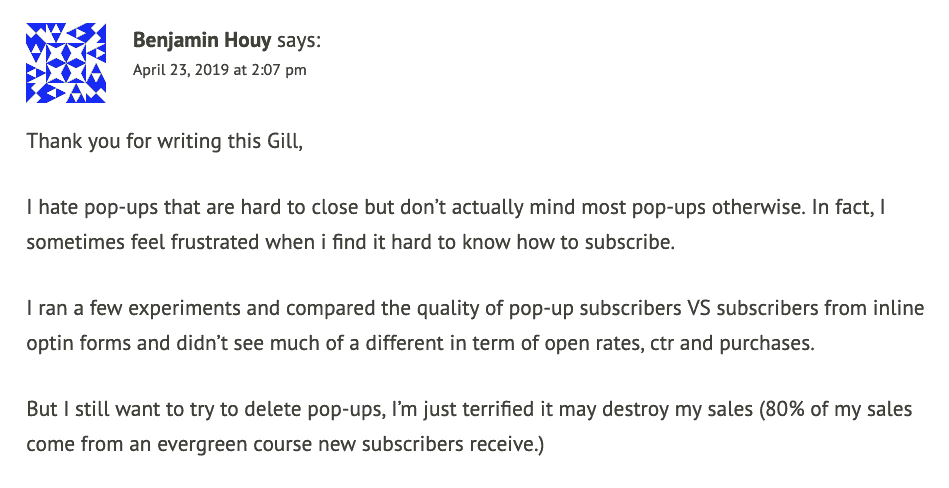
My goals wasn’t to earn a backlink but to share my thoughts on a topic I find genuinely interesting.
You will often get a nofollow backlink when you leave a comment but most importantly, you will also be more visible so other bloggers may mention you in the future when they write articles.
It’s also a great way to keep learning more about your niche.
Mention people in blog posts and let them know about it
When I write articles, I always try to mention products and people that have helped me along the way. You may have noticed I mention Ahrefs a lot, for example :).
That’s not because I earn money for doing so (Ahrefs doesn’t have an affiliate program) but simply because this is a tool I find genuinely useful.
If you regularly mention people and brands in your articles and link to them, they will take notice and may share your article or even link to you in the future.
Share the success you had with something
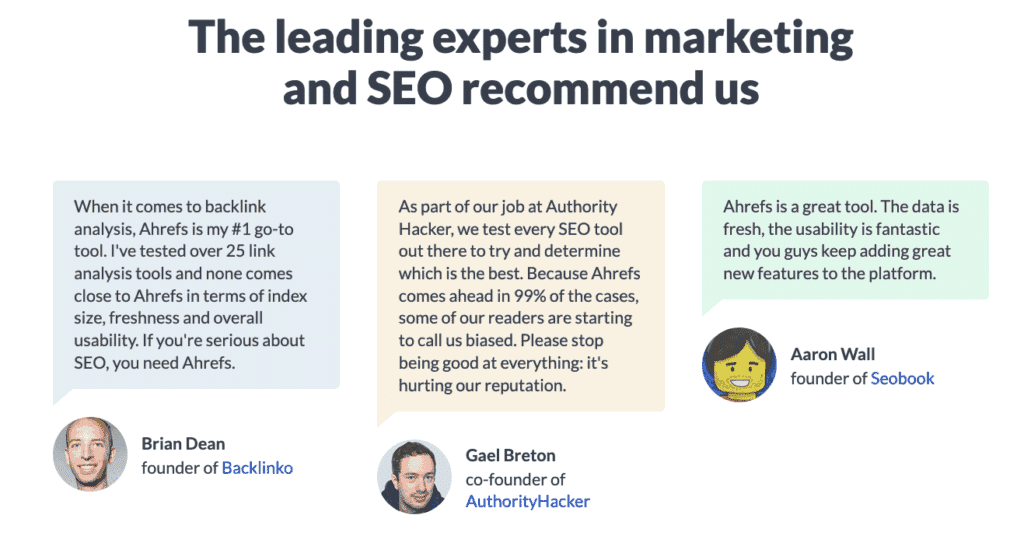
Ahrefs proudly displays testimonials and links outs to the websites of the people who wrote them.
One link building strategy I have had great success with is, ironically, a tactic I didn’t actually do on purpose: sharing my success with various products and courses.
When I finished Derek Halpern’s course Sales Page that Converts’ course, I reached out to Derek to let him know the sales page I wrote as a result was converting like crazy (by my standards.) He then published a case study about me on his blog.
When I reviewed language-learning tool FluentU, FluentU was happy to link to my review on their press page.
If you enjoy a product and have had genuine success implementing someone’s advice, let them know! You will not only make their day but are also likely to get featured as a case study or testimonial and earn a high-quality backlink in the process.
Beginner link building strategies
One frustrating aspect of link building is that many strategies require you to be well-known, to have expensive link building tools or to have a ton of content and resources.
These beginners link building strategies are simple and can be implemented even if you are just getting started as a blogger and aren’t famous yet.
Many of these techniques are techniques I used to grow French Together from 0 to 238,717 monthly visitors and can help you get more traffic to your website.
Be the source journalists need (and get featured in newspapers
This is my favorite link building technique by far because it not only works extremely well but also creates lots of value.
Every day journalists and content writers look for sources to quote in their articles. Often, they simply take a quote from an article they find on the first page of Google but they also frequently look for sources on specialized websites and social media.
If you know where to find these calls for sources and have unique tips and expert advice to offer, journalists and content writers will be happy to mention you and link to you.

Here are a few places where journalists post when they are looking for sources:
- HARO
- Source Bottle
- The #Journorequest Twitter hashtag
Here are just a few backlinks I got using these different tools:

A backlink I got after using HARO.

A backlink I got after using journorequest.
My experience is that journorequest backlinks are considerably easier to get but tend to be from smaller publications and UK publications while HARO has a more international range and is used by journalists from more major publications.
I personally prefer #journorequest because I get much more answer from journalists there but you may find that HARO or SourceBottle are a better fit if you are already well-known in your niche.
You can find a detailed breakdown of the kinds of requests journalists using #journorequest post in my article on the topic.
Find broken outgoing links
One of the first things I do when I discover a new website in my niche is check for broken pages using Ahrefs (you can also use a free tool like Dead Link Checker.)
I then check to see if some of the broken links lead to pages I could replicate or pages on topics I already wrote about.

Pinch Of Yum links to what used to be a brownie recipe. If you have one on your website, why not reach out and suggest they link to it?
If they do, I let the website know about the broken link and suggest they link to my article instead.
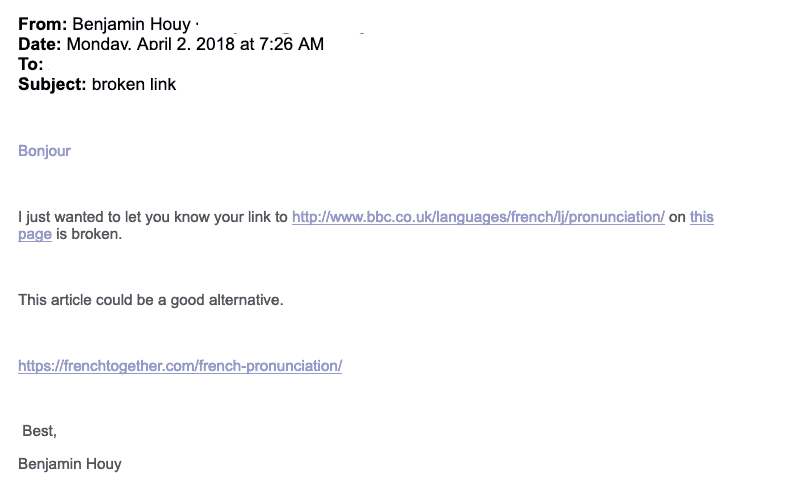
The key to success here is to offer a genuinely awesome alternative resource and not just an article that’s vaguely similar or mediocre.
If you are not sure how the broken page used to look, simply type its url in the Wayback Machine and you will see how the page looked in the past.
Note: The outreach email above did the job but I believe it could be greatly improved. I recommend checking out this list of outreach emails if you want to see what a great outreach email looks like.
Find resource pages that could link to you
Most websites have a page where they list their favorite resources and you can capitalize on that to get a backlink.
For example, if your website lists lots of vegetarian recipes, you can type “vegetarian resources” in Google to find dozens of articles listing the best resources for vegetarians.
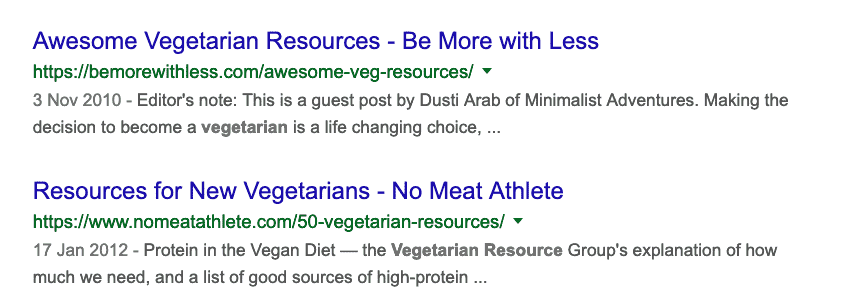
You can then reach out and suggest they list your website or resource as well.
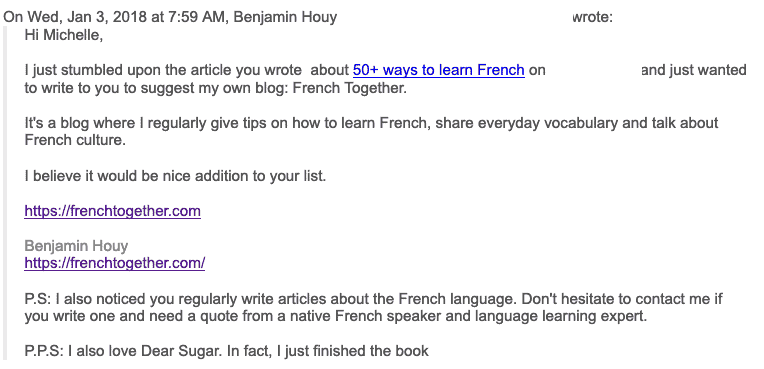
Most people will be happy to add your resource to their list if it’s truly helpful.
Sometimes, they may even offer to quote you in future articles. In fact, the email above led to the content writer mentioning me in several articles she was working on.

You may, however, have a harder time getting your resource listed if your website looks too commercial.
That’s something I realized when I used this link building strategy to get backlinks for my language-learning blog French Together.
While I could convince quite a few blogs to list French Together as a French language learning resource, I had less luck with university websites because I was often told that universities are not allowed to link to commercial resources.
Participate in expert roundups
Don’t think that only the most famous people in your niche can get listed in expert roundups.
While some expert roundups will only mention the rockstars in your niche, a lot of bloggers and journalists will be happy to feature you even if you are less well-known.
In order to find roundups to participate in, I recommend searching “expert roundup + your niche” in Google and then using relationship link building to build a relationships with people who regularly publish expert roundups.
This will put you on their radar and they will be more likely to future you in their upcoming roundups.
You can also search “expert roundup” on Twitter. You will have to sort through a lot of existing expert roundups but will also find opportunities such as this one:

An expert roundup opportunity I recently found.
Alternatively, you can reach out to people who regularly publish expert roundups and let them know you would be happy to participate in future roundups.
This is not something I have personally tried but I suspect it could work quite well provided you have already built a relationship with the person or are well-known in your niche.
Ask bloggers to review your product
If you have a great product, chances are a lot of bloggers would be happy to review it and mention it on their blog.
To find bloggers interested in reviewing your product, simply use the Twitter hashtag #bloggerswanted or #prrequest and write a tweet explaining what you are looking for.

These are fairly active hashtags so you are likely to get answers pretty quickly.
This works better if you have an affiliate program but I found quite a few bloggers who were happy to post a review of the French Together course in exchange for a free copy.
Look for unlinked brand mentions
Type the name of your site, product or your own name in Google and you are likely to find quite a few websites that talk about you or your products but don’t include a backlink.
You can then reach out to ask if they would consider adding a link.
Rand Fishkin recently tweeted that modifying your website’s Terms of service to say mentions should include a backlink makes the outreach process easier but this isn’t something I have personally tried.
If you want to make sure you don’t miss any mention, I recommend signing up for Google alerts. The tool will then email you every time someone mentions you or your brand.
Use reverse image search to look for stolen images
Most of the websites that will steal your images are spammy wesites whose backlinks you don’t want but there are also quite a few “reputable” newspapers and websites that have made stealing images without linking out to the source a habit.
You can get mad at them or you can request that they add a link to your website and enjoy the SEO benefits of their rudeness.
To make finding images easier, I recommend using Pixsy, a tool that will monitor your images and alert you when someone steals them.

Pixsy searches the web to find images websites stole from you.
The main goal of the tool is to make it easy for you to sue them and ask them to pay a fee for the images they stole but it works equally well as a way to be alerted when someone steals an image so you can ask for a backlink instead.
Alternatively, you could also use TinEye to search for individual images.
Interview experts
Getting interviewed and featured as an expert in your niche is a great way to get high-quality backlinks but the opposite also works.
If you reach out to experts and ask if you could interview them, you are likely to get quite a few affirmative answers.
Not only will this help you create valuable content for your blog but the experts you interview are likely to want to share the interview and link to it.
Post amazing guest posts
This is the last beginner link building strategy in this article but this doesn’t mean it’s not valuable. In fact, it’s one of the best ways to earn high-quality backlinks.
The reason I put it last is because it requires quite a lot more work than most of the techniques I mentioned previously.
For a guest post to be valuable, it needs to:
- Be published on a quality website.
- Contain a dofollow link to your site.
- Be a great article.
I haven’t published a guest post in years but guest posting helped me gain lots of high-quality backlinks for my blog French Together but also build relationships with other bloggers in the language-learning niche.
If you do decide to choose guest posting as a link building strategy, watch out for:
- Websites that almost exclusively post guest posts. They tend to be low quality sites that won’t promote your content.
- Websites with spammy backlinks.
- Websites full of spam comments.
Intermediate and advanced link building strategies
These are link building strategies that require more time, authority or skills
They could work great for you but I recommend starting with beginner link building strategies first as they tend to be easier/cheaper to execute.
The Skysraper technique

Invented by Brian Dean from Backlinko, the Skyscraper technique is all about finding content that could be improved, making it 10 times better and then reaching out to people who link to the content to ask them to link to your article instead.
It sounds simple but it requires lots of work (especially if the articles on the topic are already pretty good.)
You could improve content by:
- Being more comprehensive (listing 15 recipes instead of 4 or including step-by-step instructions or a video.)
- Adding stunning visuals (images, infographics…)
- Creating a tool, an interactive map…
I consider this an intermediate/advanced link building technique because, depending on the niche, creating much better content could potentially mean having to hire a designer or creating a tool.
But this doesn’t mean you shouldn’t give it a try. The Skyscraper Technique is a great way to quickly build authority and baclinks if your competitors’ articles tend to be low quality.
Attract backlinks with the Snowmaker Strategy
Websites that rank at the top tend to naturally attract backlinks just because they are the most visible.
This phenomenon called the vicious circle of SEO or snowball effect is one of the most frustrating aspects of SEO.
That’s why I was particularly intrigued when Kyle Byers from GrowthBadger mentioned a link building technique new websites can use to benefit from the snowball effect without having to rank high: the Snowmaker Strategy.
The idea behind this ingenious strategy is to write a link bait article, that is an article that is likely to attract backlinks, and buy ads so journalists and content writers writing about the topic see it and link to it.
This article about blog statistics is a great example of the Snowmaker Strategy in action. Seeing that articles listing statistics tend to attract lots of backlinks, Kyle decided to buy Google ads targetting the keyword “blogging statistics.”

The ad Kyle Byers ran to earn backlinks to his article about blog statistics.
This resulted in several high-quality backlinks a new website like GrowthBadger would have otherwise struggled to get.

Using the Snowmaker Strategy helped GrowthBadger earn quality backlinks (although it’s important to note that some of the backlinks were generated using email outreach.)
Here is what Kyle told me about the Snowmaker Strategy:
You have to be careful with the Snowmaker Strategy, because it won’t work with every piece of content you produce. Do it wrong and you can waste a lot of money. Do it right and you can passively build links inexpensively.
To make it work, you have to target keywords with high linking intent: phrases that bloggers and journalists are likely to search for when they’re doing research for an article, or when they need to cite a source for a point they’re making.
For example, “[your topic] statistics” or “[your topic] research” or “[your topic] facts”. If you’re creative you can probably come up with a bunch more possibilities, but be surgical: quality over quantity.
Kyle Byers - Founder of GrowthBadger
Find broken pages that mention the topic you wrote about
Recently, the folks at Ahrefs released a pretty awesome update of their Content Explorer tool which allows you to specifically look for broken links.
So instead of simply looking for broken links on the websites you visit, you can use Ahrefs Content Explorer to look for all broken links in articles referencing a topic.
Let’s say you would like to build backlinks for an article about huskies. You can simply open Ahrefs Content Explorer, type “husky” and select “only broken.” The tool will then show you all the broken pages mentioning huskies.

Ahrefs content explorer shows you broken pages on any topic you like.
You then simply need to look at the list of referring domains and contact the websites linking to the broken page to ask them to link to your page instead.
Steal your competitors’ broken backlinks
To find your broken backlinks with Ahrefs, start by entering the url of your competitor’s website in the Site Explorer tool.

Then, click on “best by links” in the menu on the left side of the page. This will lead you to the “best by links” report.

Then, select “404 not found” as HTTP code.
You will then see the list of all your competitor’s broken pages ordered by the number of backlinks they have.
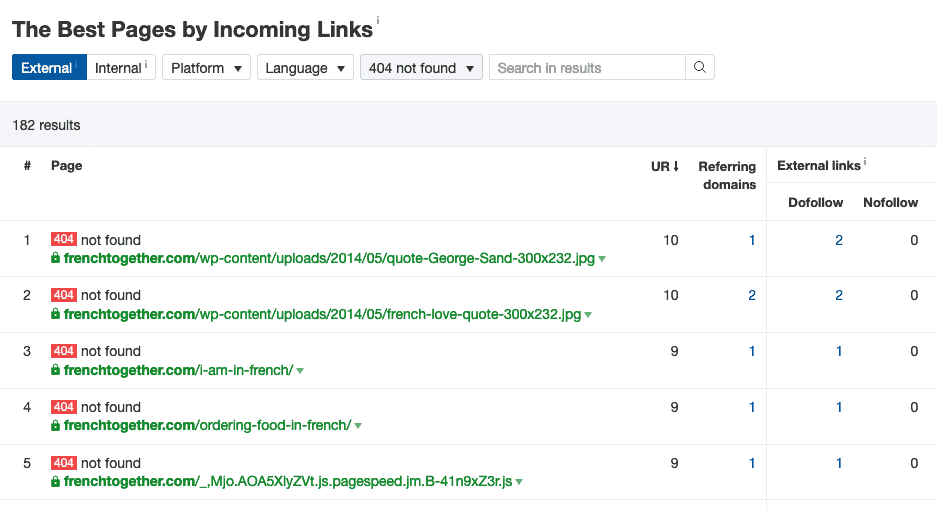
You can then recreate the broken pages (if you don’t already have a replacement to offer) and reach out to the site linking to your competitor to suggest they link to your article instead.
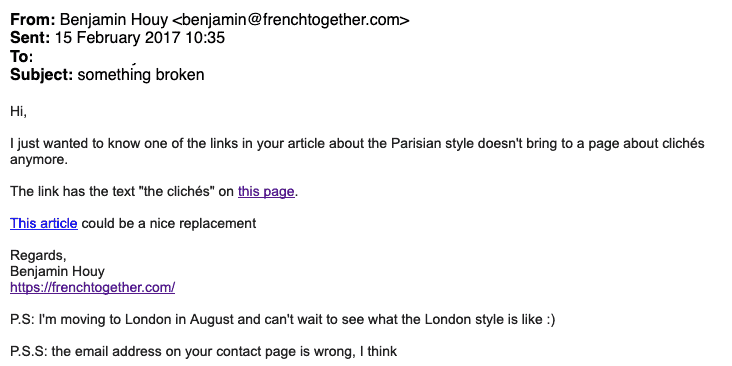
In most cases, people will happily fix the broken link and link to you.
Fix your broken backlinks
Finding other people’s broken backlinks and suggesting alternatives is smart but lots of people forget to check their own broken backlinks.
If your website is more than a few months old, chances are you have quite a few broken pages people are linking to. This is a huge waste because backlinks that lead to a broken page are not taken into account by Google.
To find your broken backlinks, simply follow the procedure I just described above with you own website instead of your competitor’s website.
You can then recreate the broken pages or set up redirects to make sure all the backlinks you have are not wasted.
Find people who want to interview you
If you have expertise to share, a lot of bloggers will be happy to interview you.
To find such opportunities, simply type “interview series “blogger” (replace blogger by your niche) in Google.
You could also type:
- interview series “food bloggers”
- food blogger interviews
You will then find websites that regularly interview people and just need to reach out to see if they would like to interview you.

While this is a technique that worked well for me in the language learning niche, I have to admit my effort to be interviewed by marketing/SEO blogs were not successful. This could be because people in the make money online niche receive way more requests or simply because I’m less well-known in the niche.
I see many people looking for interviewees In niches like cooking, wellness or lifestyle blogging and suspect this link building strategy would work extremely well if you are in one of these niches.
Monitor your competitors’ backlinks (and replicate them)
Monitoring my competitors’ backlinks is a great link building strategy and one of the best things I ever did in term of SEO.
Every month, I look at the report I receive from Ahrefs and find competitor backlinks I could replicate.
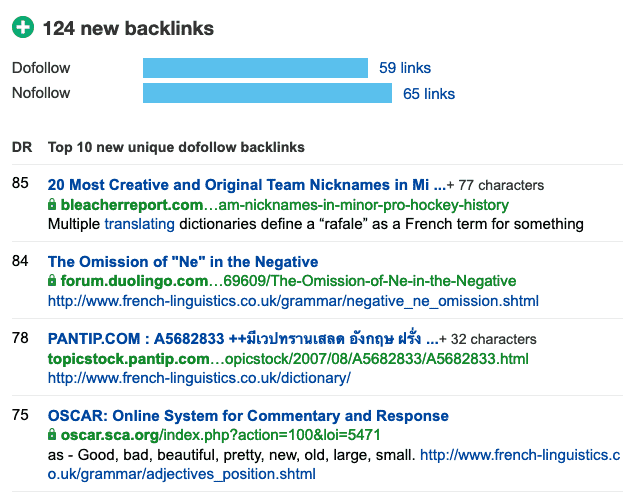
A few of the new backlinks one of my competitors gained.
My competitor got interviewed by a newspaper? I reach out to see if they would like to interview me as well.
Another blog was mentioned on a resource page? I reach out and suggest they add my blog as well.
I personally use Ahrefs to monitor my competitors backlinks but you could also use the following tools:
Monitor Backlinks (starts at $24 90/month)
SEMrush (starts at $99 .95/month
The most important is to monitor the backlinks of competitors who write about the same topics as you and attract a similar audience. This way, you are likely to find that a lot of their backlinks are backlinks you could easily replicate.
For example, I initially started monitoring the backlinks of the now defunct BBC learn French website but quickly realized that the type of sites that were linking to it (mostly universities and government websites) wouldn’t link to a commercial blog like French Together, so I stopped.
Sometimes, monitoring the backlinks a small blog makes more sense than monitoring the backlinks of the biggest website in your niche because people linking to well-known publications are less likely to link to you if you aren’t as well-known.
Donate to charity (and get a sweet backlink in exchange)
Donation links are a gray area and different people will have a different opinion on this particular link building strategy.
The idea is to look for charities, open-source projects and NGOs that publish lists of donors and links to their website and then donate in order to get a backlink.
There is no doubt that this link building strategy works. In fact, you just need to look at the link profile of promocodewatch.com to notice that most of their backlinks are donation links from open-source projects.

Promocodewatch’s top backlinks are almost all donation links.
And while people have been warning that Google could penalize websites using it for years, this still doesn’t seem to be the case.
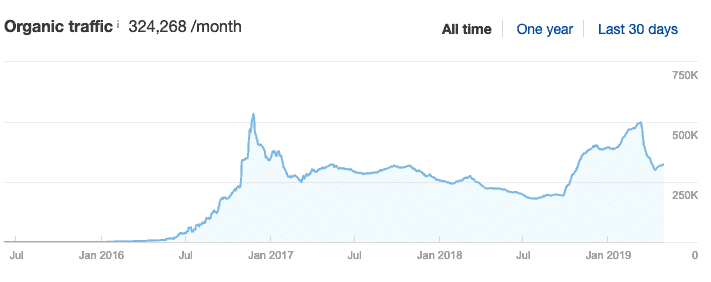
This is not a link building strategy I would personally use or recommend but it’s good to be aware of its existence so you can recognize it if you see your competitors using it.
Hire content writers (and get featued in their portfolio)
Lots of content writers have a portfolio page where they link to all the articles they publish, something you could take advantage of to build links.
In fact, if you look at the backlinks of any blog or website that regularly hires content writers, you will notice that quite a few of the backlinks come from portfolio pages.
All you need to do is hire a content writer who has a portfolio page, ask them to write an article and hope that they will link to the article from their portfolio.
Worst case scenario, you end up with a nice article to publish on your website.
Offer a scholarship
Universities and school love to promote products and courses their students could get for free.
If you have something genuinely useful to offer, you could create a scholarship page explaining what it is and how to get it and then reach out to schools and universities to ask them to mention it on their website.
To find websites that promote scholarships opportunities in your niche, simply head to Google and type one of the following queries:
- site:.edu “scholarships”
- site:.ac.uk “scholarships”
Reach out to people who interviewed/featured you

Want to easily build high-quality backlinks in a matter of minutes?
Make a list of all the people who interviewed you or published your content in the past and ask them to link to your new project.
I have done a ton of podcasts (about 250! also a great link building tactic for the record) to promote my previous business and now I’m launching a new one. So I’ve been emailing the podcast host asking them to update my bio with my new business. I did my first batch yesterday and about half of them emailed me back saying they had updated their site in under 24 hours!
Laura Roeder - Founder of Paperbell Coaching Software
Have you experimented with any of these link building strategies? How did it go?